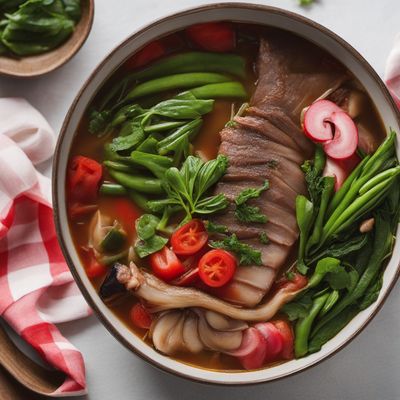
Recipe
Djiboutian-Inspired Sotanghon Stir-Fry
Savory Djiboutian Sotanghon Delight
4.7 out of 5
Indulge in the flavors of Djiboutian cuisine with this delectable twist on the classic Filipino dish, Pancit Sotanghon. This Djiboutian-inspired recipe combines the delicate and chewy sotanghon noodles with aromatic spices and vibrant vegetables, resulting in a satisfying and flavorful stir-fry.
Metadata
Preparation time
20 minutes
Cooking time
15 minutes
Total time
35 minutes
Yields
4 servings
Preparation difficulty
Easy
Suitable for
Vegetarian, Vegan (omit oyster sauce), Gluten-free (use gluten-free soy sauce)
Allergens
Soy
Not suitable for
Paleo, Keto
Ingredients
In this Djiboutian-inspired adaptation of Pancit Sotanghon, we incorporate Djiboutian spices such as cumin, coriander, and turmeric to infuse the dish with a distinct flavor profile. Additionally, we use Djiboutian vegetables like okra, eggplant, and bell peppers to add a vibrant touch to the stir-fry. We alse have the original recipe for Pancit sotanghon, so you can check it out.
-
200g (7 oz) sotanghon noodles 200g (7 oz) sotanghon noodles
-
2 tablespoons vegetable oil 2 tablespoons vegetable oil
-
1 onion, thinly sliced 1 onion, thinly sliced
-
3 cloves garlic, minced 3 cloves garlic, minced
-
1 teaspoon cumin powder 1 teaspoon cumin powder
-
1 teaspoon coriander powder 1 teaspoon coriander powder
-
1/2 teaspoon turmeric powder 1/2 teaspoon turmeric powder
-
200g (7 oz) okra, sliced 200g (7 oz) okra, sliced
-
1 eggplant, cut into strips 1 eggplant, cut into strips
-
1 red bell pepper, sliced 1 red bell pepper, sliced
-
2 tablespoons soy sauce 2 tablespoons soy sauce
-
1 tablespoon oyster sauce 1 tablespoon oyster sauce
-
Salt and pepper to taste Salt and pepper to taste
-
Fresh cilantro, for garnish Fresh cilantro, for garnish
Nutrition
- Calories (kcal / KJ): 250 kcal / 1046 KJ
- Fat (total, saturated): 8g, 1g
- Carbohydrates (total, sugars): 40g, 6g
- Protein: 5g
- Fiber: 4g
- Salt: 2g
Preparation
-
1.Soak the sotanghon noodles in warm water for about 10 minutes or until softened. Drain and set aside.
-
2.Heat the vegetable oil in a large pan or wok over medium heat.
-
3.Add the sliced onion and minced garlic to the pan and sauté until fragrant and translucent.
-
4.Sprinkle the cumin powder, coriander powder, and turmeric powder over the onions and garlic. Stir well to coat the aromatics with the spices.
-
5.Add the sliced okra, eggplant, and red bell pepper to the pan. Stir-fry for about 5 minutes or until the vegetables are tender.
-
6.Push the vegetables to one side of the pan and add the soaked sotanghon noodles to the other side. Pour the soy sauce and oyster sauce over the noodles and gently toss to combine with the vegetables.
-
7.Continue stir-frying for another 3-4 minutes or until the noodles are heated through and well-coated with the sauces.
-
8.Season with salt and pepper to taste.
-
9.Garnish with fresh cilantro and serve hot.
Treat your ingredients with care...
- Sotanghon noodles — Be sure to soak the noodles in warm water until they are softened but still slightly firm to the bite. Over-soaking can result in mushy noodles.
- Okra — To prevent okra from becoming slimy, make sure to slice it just before cooking and avoid overcooking.
- Eggplant — Salting the eggplant strips and letting them sit for a few minutes before cooking can help remove any bitterness.
Tips & Tricks
- For a spicier kick, add a pinch of Djiboutian chili powder or cayenne pepper.
- Customize the stir-fry by adding Djiboutian protein sources such as grilled chicken or shrimp.
- If sotanghon noodles are not available, you can substitute with rice vermicelli or thin rice noodles.
- To enhance the flavors, squeeze some fresh lemon or lime juice over the finished dish.
- Leftovers can be refrigerated and enjoyed the next day. Simply reheat in a pan or microwave, adding a splash of water or broth to prevent drying.
Serving advice
Serve the Djiboutian-inspired Sotanghon Stir-Fry as a main course, accompanied by a fresh salad or Djiboutian flatbread. It can also be served as a side dish alongside grilled meats or fish.
Presentation advice
Garnish the stir-fry with a sprinkle of fresh cilantro to add a pop of color. Serve it in a vibrant Djiboutian-inspired dish or on a bed of lettuce for an appealing presentation.
More recipes...
More Filipino cuisine dishes » Browse all

Baye baye
Baye baye is a traditional Filipino dessert that is perfect for special occasions. The dish is made by simmering sweet glutinous rice in coconut...

Pichi-pichi
Pichi-Pichi
Pichi-pichi is a traditional Filipino dessert that is sweet, chewy, and made with cassava.

Utan
Vegetable soup
Utan is a traditional Filipino soup made with vegetables and coconut milk.







